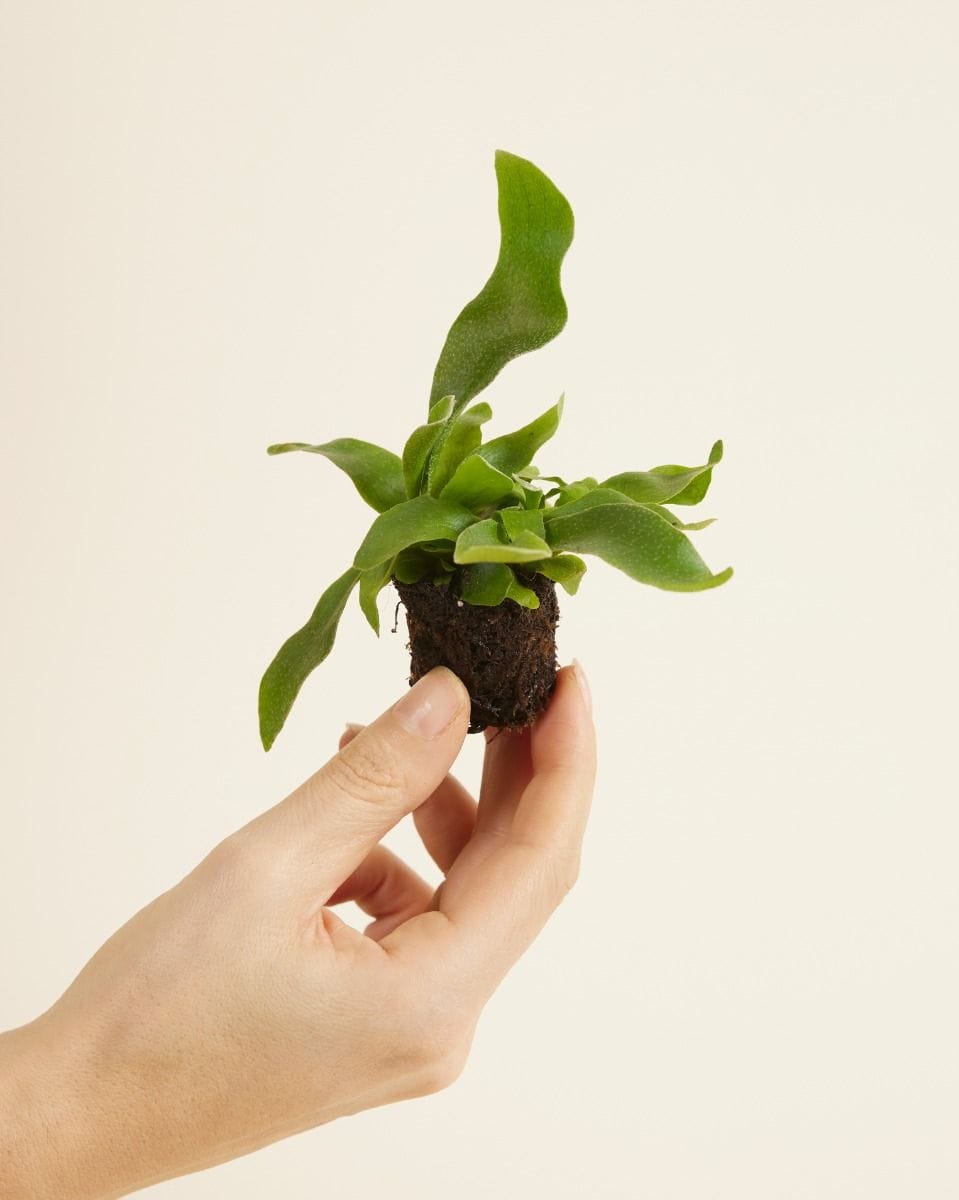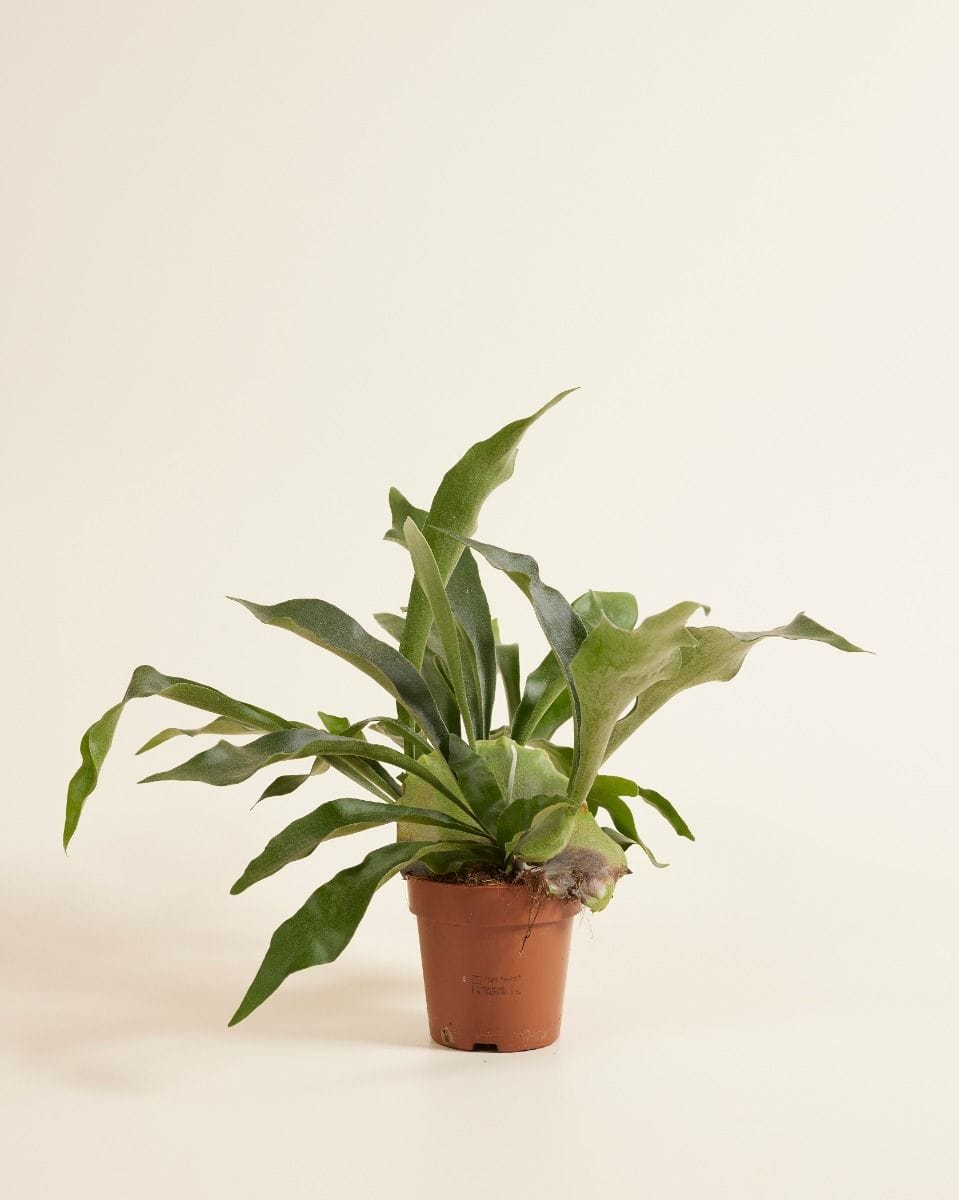In dit artikel
- 1 Verzorging van Platycerium (Hertshoornvaren): Deskundige tips voor bloeiende planten
- 1.1 Verzorging van de varen: 10 tips van experts voor een succesvolle kweek
- 1.2 Platycerium verzorgingstips
- 1.2.1 Lichteisen
- 1.2.2 Water geven
- 1.2.3 Plantenvoeding
- 1.2.4 Temperatuur en luchtvochtigheid
- 1.2.5 Verpotten en potgrond
- 1.3 Platycerium vermeerdering
- 1.4 Meest voorkomende plagen op Platycerium
- 1.5 Zijn Platycerium giftig voor je huisdieren of kinderen?
- 1.6 Koop je nieuwe Platycerium online bij PLNTS.com
Verzorging van Platycerium (Hertshoornvaren): Deskundige tips voor bloeiende planten
Heb je ooit gehoord van de Hertshoornvaren? Dit is de bijnaam voor de prachtige planten van de Platycerium familie, een geslacht met 18 prachtige varensoorten. Als je ze goed verzorgt, kunnen ze heel lang meegaan als kamerplant. Hoewel ze langzaam groeien, moet je niet raar opkijken als ze uiteindelijk meer dan een meter lang worden!
Ze groeien uit een klein deel dat wortelstok wordt genoemd en hebben twee soorten bladeren. De eerste soort helpt de wortels beschermen en vangt bij sommige soorten zelfs water op. Het tweede soort blad helpt de plant om meer varens te maken. Sommige soorten van deze varens hebben maar één wortelstok - zij zijn de solo-artiesten van de familie!
Deze fascinerende planten komen uit tropische en gematigde delen van Afrika, Zuid-Amerika, Nieuw-Guinea en Australië. Maar het meest interessante en leuke aan dit geslacht is dat ze epifytisch zijn, wat betekent dat ze op andere planten groeien zonder te parasiteren. Hoe cool is dat!

Verzorging van de varen: 10 tips van experts voor een succesvolle kweek
- Zoek een plek uit de buurt van direct zonlicht. Een plek met veel indirect natuurlijk licht is ideaal voor je Hertshoornvaren. De tere bladeren kunnen beschadigd raken door fel, direct zonlicht.
- Ze zijn gevoelig voor overbewatering, dus wees voorzichtig. Hij droogt het liefst een beetje uit tussen twee besproeiingen door, dus wacht tot minstens de helft van de grond droog is voordat je weer water geeft.
- Giet geen water direct op de bladeren, vooral niet op die met een zacht wit laagje. Deze beschermende laag, eenmaal verloren, regenereert niet en maakt de plant vatbaarder voor problemen.
- Een hoge luchtvochtigheid is de sleutel tot het hart van de plant. Houd de luchtvochtigheid hoog en houd de varen tevreden met een luchtbevochtiger of een waterbak met kiezels.
- Bemest af en toe, maar overdrijf het niet. Ze hebben niet veel mest nodig. Lichte voeding in het voorjaar en de zomer is meestal voldoende om deze plant gezond te houden.
- Platycerium is een epifytische plant die houdt van een grove potgrond mix. Door de grove samenstelling is de PLNTS epifyten potgrond mix kit een uitstekende keuze.
- Vermijd het verstoren van de schild bladeren. Het lijkt misschien alsof ze afsterven, maar dit is een normaal groeiproces van de plant en beschermt de wortels. Verwijder ze koste wat het kost niet!
- Je kunt je Platycerium ophangen voor een natuurlijker groeipatroon. Boots hun inheemse boomstam habitat na met een stuk hout. Bedek de wortels met sphagnum mos en bevestig ze aan het stuk hout.
- Houd een oogje in het zeil voor eventuele problemen. Platycerium planten zijn over het algemeen vrij van plagen, maar trekken soms schildluizen en wolluizen aan. Let op veranderingen in de bladeren die kunnen wijzen op een probleem.
- Zorg ervoor dat de plant genoeg ruimte heeft. Platycerium houdt er niet van om opeengepakt te staan met andere planten. Door hem een beetje apart te houden van andere kamerplanten kan je de verspreiding van ongedierte voorkomen en ervoor zorgen dat hij het licht en de lucht krijgt die hij nodig heeft.
Platycerium verzorgingstips
Lichteisen
Omdat de meeste van deze prachtige Hertshoorvarens uit tropische tot gematigde gebieden komen, houden ze van helder maar indirect zonlicht. Zorg ervoor dat je de lichtste plek in huis vindt voor je Hertshoornvaren, en hij zal je bedanken met prachtig lichtgroen blad!
Als er voldoende licht in de kamer is, maar de plant niet direct wordt geraakt, kun je hem bijna overal neerzetten - op een tafel, een plank of hangend aan het plafond. Vergeet alleen niet om haar uit direct zonlicht te houden.
Water geven
Zoals gezegd is je Hertshoornvaren een sterke groene schoonheid. Vanwege de grote afschermende bladeren die de wortel beschermen, raden we aan om haar van onderaf water te geven. Laat haar 10 tot 15 minuten in het water staan en zorg ervoor dat het overige water uit de pot kan lopen. Die schild bladeren kunnen gemakkelijk gaan rotten.
Expert tip! Als de bladeren van je Platycerium bruin beginnen te worden, geef je waarschijnlijk te veel water. Onderzoek de grond en pas je bewateringsroutine een beetje aan.
Geef niet te veel water en controleer altijd de grond voordat je weer water geeft. Je kunt een watermeter gebruiken of de grond met je vinger door de drainagegaten aanraken. Als de grond is uitgedroogd, moet je hem opnieuw water geven. Het heeft geen zin om de grond van bovenaf te voelen als je van onderaf water geeft, omdat de grond van bovenaf dan constant droger is. Vergeet niet dat je Hertshoornvaren 's winters minder water nodig heeft omdat hij dan rust.
Plantenvoeding
De Hertshoornvaren is geen grote eter; in feite is zij behoorlijk gevoelig voor overbemesting. Een vloeibare meststof zoals onze organische PLNTS voeding kan tijdens het groeiseizoen een keer per maand worden gebruikt om haar te helpen beter te gedijen en haar unieke bladeren te laten schitteren in je huis.

Temperatuur en luchtvochtigheid
Houd de temperatuur rond 18-27°C en de luchtvochtigheid rond 40-70%, en jouw Hertshoornvaren zal een gelukkige kamerplant zijn. Hij kan korte periodes van koudere temperaturen verdragen (minimaal 10°C). Als de lucht bij jou thuis te droog is, lees dan hoe je de luchtvochtigheid voor kamerplanten kan verhogen.
Expert tip! Badkamers en keukens (met ramen!) zijn een paradijs voor deze planten omdat ze houden van plekken met veel vocht in de lucht.
Verpotten en potgrond
Hertshoornvaren of Platycerium planten zijn epifyten, wat betekent dat ze van nature op andere planten of bomen groeien in plaats van in de grond. Deze planten hoeven niet traditioneel verpot te worden en kunnen er wel baat bij hebben. Als alternatief kunnen ze op houten planken of houten stukken met sphagnum mos worden gezet om een medium voor groeiende wortels te creëren.
Als je ervoor kiest om je Staghorn Fern in pot te zetten, gebruik dan de PLNTS Epiphytes mix kit die luchtig is en grote brokken heeft, wat ideaal is voor jouw plant. Overweeg om haar te verpotten als de wortels uit de drainage gaten beginnen te komen.
Platycerium vermeerdering
Vind je je Hertshoornvaren zo mooi dat je er nog een versie van wilt? Met de juiste apparatuur is dat in een handomdraai voor elkaar!
Er zijn twee manieren om je Platycerium te vermeerderen. Om je plant niet te shockeren, kun je haar vermeerderen door middel van sporen, maar dit is een langzaam proces en we weten dat PLNTSlovers ongeduldig zijn als het op planten aankomt! De andere manier is door de plant te delen. Je hebt een kleine schaar of een scherp mes nodig om de jonge uitlopers of 'pups' voorzichtig af te knippen. Zorg ervoor dat je jongen kiest die beide soorten bladeren hebben - de sporenvormende en de ronde, platte bladeren. Bewaar je nieuwe babyvaren na het stekken op een warme en vochtige plek tot hij uit zichzelf begint te groeien.

Meest voorkomende plagen op Platycerium
Hertshoornvaren zijn erg sterk en worden niet vaak geïnfecteerd door ongedierte. Maar als je ze niet goed vertroeteld of als ze te weinig vocht hebben, kunnen er vervelende insecten opduiken die misbruik maken van de zwakte van je Platycerium. Zachte schildluizen zijn de meest voorkomende, maar soms kunnen wolluizen je plant ook infecteren. Als je iets verdachts op je plant vindt, kijk dan gerust op onze PLNTSdoctor pagina om ongedierte te herkennen en te elimineren!
Zijn Platycerium giftig voor je huisdieren of kinderen?
Naast dat ze prachtig, sterk en schattig zijn, bevat de Platycerium familie alleen veilige planten voor kinderen en huisdieren in het geslacht! Dus wees niet bang om je harige vrienden bij je groene dame te laten komen, en misschien worden ze wel beste vrienden!
Koop je nieuwe Platycerium online bij PLNTS.com
Bij PLNTS.com hebben we de prachtige Baby Platycerium Bifurcatum en haar schattige groene blaadjes. Als je je Hertshoornvaren wilt zien uitgroeien tot een volwassen en ongelooflijke varen, dan is dit de beste optie! Bekijk anders de volwassen Platycerium Bifurcatum. Koop Platycerium online bij PLNTS.com.


